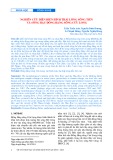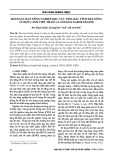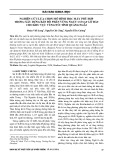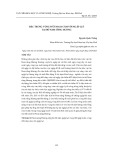
TNU Journal of Science and Technology
229(15): 69 - 77
http://jst.tnu.edu.vn 69 Email: jst@tnu.edu.vn
IMPROVING PRECIPITATION ESTIMATION ACCURACY
FOR THE CENTRAL VIETNAM REGION USING THE XGBOOST MODEL
WITH MULTI-SOURCE DATA
Vu Duy Dong1,
Nguyen Hung An1*, Nguyen Tien Phat
1, Nguyen Thi Nhat Thanh2, Nguyen Thi Huyen1
1Le Quy Don Technical University
2University of Engineering and Technology -
Vietnam National University, Hanoi
ARTICLE INFO
ABSTRACT
Received:
17/10/2024
This paper presents a novel approach to enhancing the accuracy of
precipitation estimation in Central Vietnam using the Extreme Gradient
Boosting (XGBoost) machine learning model. The proposed method
integrates multi-source data, combining satellite imagery from
Himawari-8, atmospheric reanalysis from ERA-5, and digital elevation
models from ASTER DEM to train the model. Rain gauge data from
175 stations across the region are used as target labels for validation.
The proposed model achieved a CSI of 0.45, a POD of 0.75, and an
RMSE of 4.53, with improvements of 11.11% to 86.67%, 28% to
93.33%, and 16.99% to 51.87%, respectively, compared to other
precipitation products such as IMERG-Final Run, GSMaP_MVK,
FengYun 4A, and PERSIANN-CCS. Detailed rainfall maps generated
by the proposed model were compared with radar imagery during
rainfall events, demonstrating a high degree of similarity. Furthermore,
this approach serves as the basis for running near-real-time rainfall
estimation models for the region of Vietnam.
Revised:
22/11/2024
Published:
22/11/2024
KEYWORDS
Rainfall estimation
Machine learning
XGBoost model
Himawari-8 satellite data
Digital elevation model
TĂNG CƯỜNG ĐỘ
CHÍNH XÁC TRONG DỰ
BÁO LƯỢNG MƯA
Ở
KHU VỰC MIỀN TRUNG VIỆT NAM SỬ
DỤNG MÔ HÌNH XGBOOST
CHO DỮ
LIỆU ĐA NGUỒN
Vũ Duy Đông1,
Nguyễn Hùng An1*, Nguyễn Tiến Phát
1, Nguyễn Thị
Nhật Thanh2, Nguyễn Thị
Huyền1
1Trường Đại học Kỹ thuật Lê Quý Đôn
2Trường Đại học Công nghệ
-
Đại học Quốc gia Hà Nội
THÔNG TIN BÀI BÁO
TÓM TẮT
Ngày nhận bài:
17/10/2024
Bài báo này trình bày một cách tiếp cận mới để nâng cao độ chính xác
trong ước tính lượng mưa tại miền Trung Việt Nam bằng cách sử dụng
mô hình học máy Extreme Gradient Boosting (XGBoost). Phương pháp
đề xuất tích hợp dữ liệu đa nguồn, kết hợp hình ảnh vệ tinh từ
Himawari-8, phân tích lại khí quyển từ ERA-5 và mô hình độ cao kỹ
thuật số từ ASTER DEM để đào tạo mô hình. Dữ liệu đo mưa từ 175
trạm trên khắp khu vực được sử dụng làm nhãn mục tiêu để xác thực.
Mô hình đề xuất đạt được CSI 0,45, POD 0,75 và RMSE 4,53, với mức
cải thiện lần lượt từ 11,11% tới 86,67%, 28% tới 93,33% và 16,99% tới
51,87%, so với các sản phẩm lượng mưa khác như IMERG-Final Run,
GSMaP_MVK, FengYun 4A và PERSIANN-CCS. Bản đồ lượng mưa
chi tiết do mô hình đề xuất tạo ra đã được so sánh với ảnh radar trong
các sự kiện mưa, chứng minh mức độ tương đồng cao. Hơn nữa,
phương pháp này tạo cơ sở để chạy các mô hình ước tính lượng mưa
gần thời gian thực cho khu vực Việt Nam.
Ngày hoàn thiện:
22/11/2024
Ngày đăng:
22/11/2024
TỪ KHÓA
Ước tính lượng mưa
Học máy
Mô hình học máy XGBoost
Dữ liệu vệ tinh Himawari-8
Mô hình độ cao số
DOI: https://doi.org/10.34238/tnu-jst.11346
* Corresponding author. Email: hungan@lqdtu.edu.vn






























